What’s in a name? Discover whether this ancient Greek offering is an idealized young woman or a goddess.
Peplos Kore, c. 530 B.C.E., marble, 1.2 m high, from the Acropolis, Athens, Greece (Acropolis Museum, Athens). Speakers: Dr Beth Harris and Dr. Steven Zucker
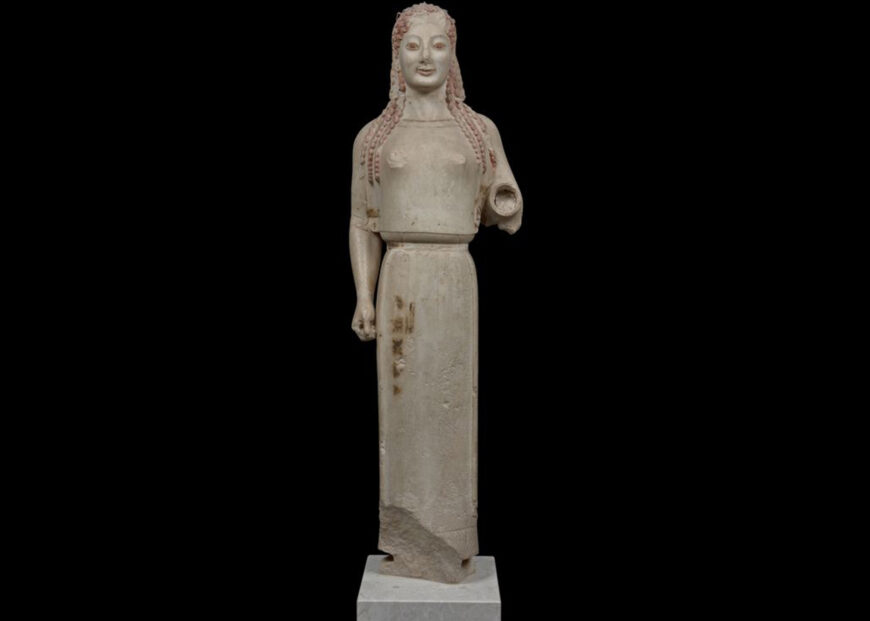
Peplos Kore, c. 530 B.C.E., marble, 1.2 m high (Acropolis Museum, Athens)
The Acropolis was one of the holiest places in ancient Athens, full of temples and dedications to the gods. In 480 B.C.E., many of the sacred buildings and statues on the site were damaged by an invading army. In the decades that followed, the people of Athens carefully buried some of these broken votives in pits on the Acropolis, keeping them within the confines of the holy land but removing them from view. Thousands of years later, in 1886, Greek archaeologists excavated one of these pits just northwest of a temple known as the Erechtheion. Within it they found several statues of young women. The most famous of them is today known as the Peplos Kore.
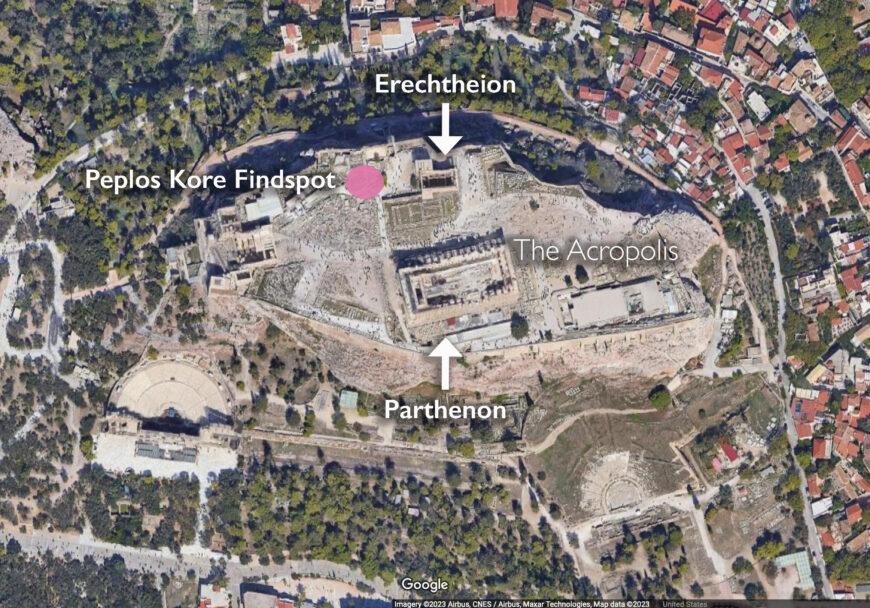
Acropolis, Athens with the findspot of the Peplos Kore, the Erechtheion, and the Parthenon (underlying map © Google)
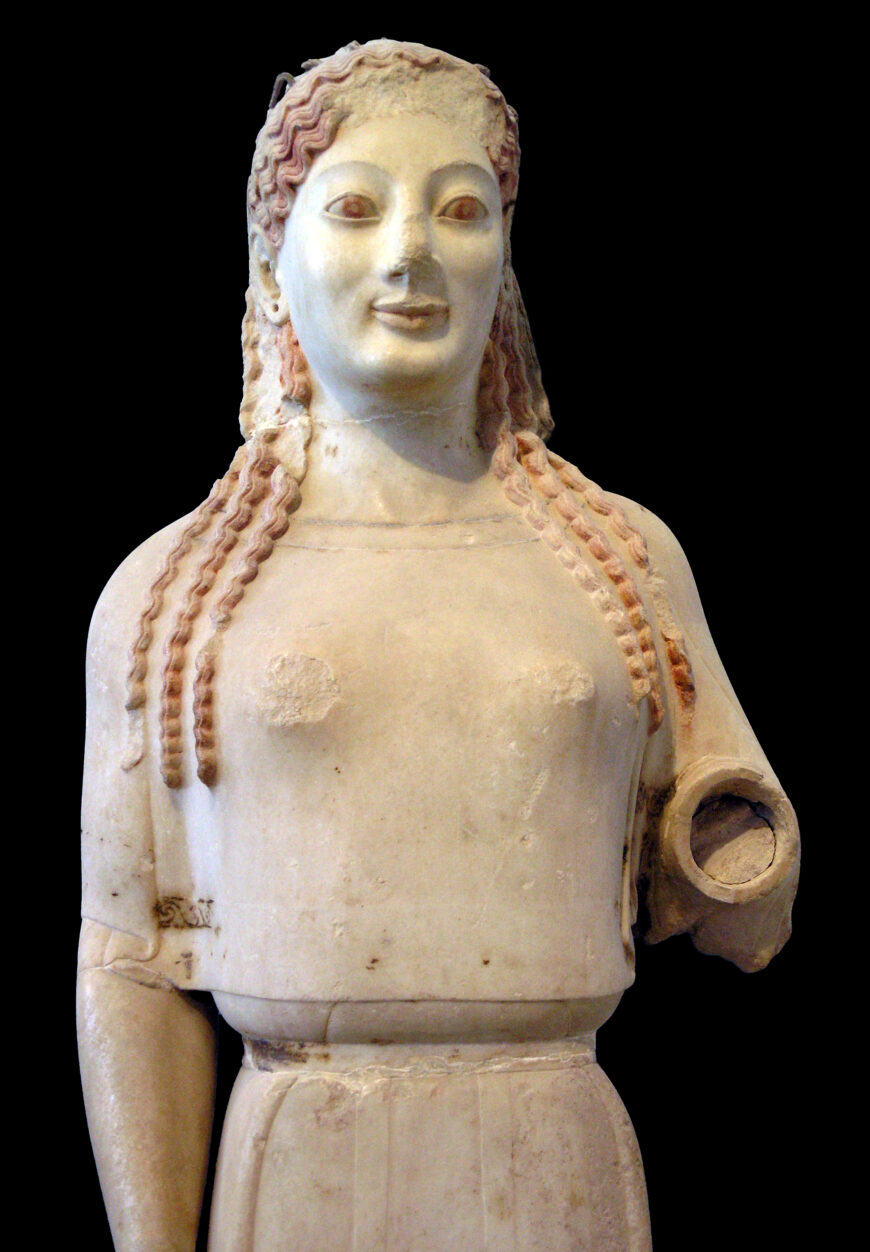
Head and torso (detail), Peplos Kore, c. 530 B.C.E., marble (Acropolis Museum, Athens; photo: Marsyas, CC BY-SA 2.5)
When she was first found, the Peplos Kore was recognized as an especially beautiful example of the kore (plural: korai) statue type. Korai are statues of richly dressed young women that were popular in the Archaic period. Archaeologists also believed she wore a simple garment called a peplos, and so she came to be called the Peplos Kore. However, new research focused on the paint and metal additions that once adorned the Peplos Kore has revealed that she is wearing a different garment altogether, and may in fact represent a goddess. In the following paragraphs, we will consider how the Peplos Kore compares to other Archaic korai and how her original appearance differs from her contemporary one.
Like other korai, the Peplos Kore represents an idealized young woman. Her face is smooth and symmetrical, embodying the Archaic ideal of female perfection. Her slight smile, known as the Archaic smile, is another trait that is typical of korai and their male counterparts, kouroi (singular: kouros). The Archaic smile is meant to convey a sense of liveliness rather than signal a happy emotion. The Peplos Kore’s hair is carefully combed and styled into wavy strands, which are further detailed with carved lines that indicate individual hairs. [1] Three of these strands fall in front of each of her shoulders, adding to the overall sense of symmetry in the statue. The kore’s elaborate hairstyle resembles those of other Archaic korai and contributes to the impression that the woman represented here is an idealized, if generic, elite.
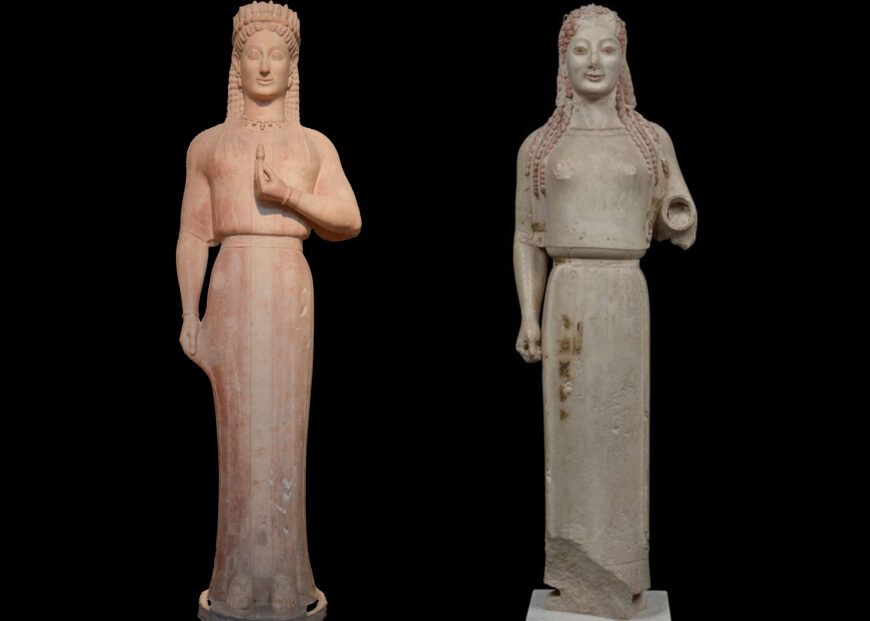
Left: Phrasikleia Kore, c. 540 B.C.E., marble, 1.76 m high (National Archaeological Museum, Athens; photo: Carole Raddato, CC BY-SA 2.0); right: Peplos Kore, c. 530 B.C.E., marble, 1.2 m high (Acropolis Museum, Athens)
Upon first glance, the Peplos Kore seems to have the same rigid posture that we expect of Archaic korai. However, looking more closely reveals that she is slightly asymmetrical. Her shoulders are not completely straight like those of the stiffer Phrasikleia Kore. Instead, the Peplos Kore’s left shoulder is very slightly higher than her right, reacting to the movement of her arm, which (though now missing) once reached out in front of her. The bottom of her cape is not exactly parallel to her belt, rising up slightly on the right. Her head turns a tiny bit to the left. [2] All of these small adjustments make the Peplos Kore appear more natural and lifelike than many other Archaic korai. [3]
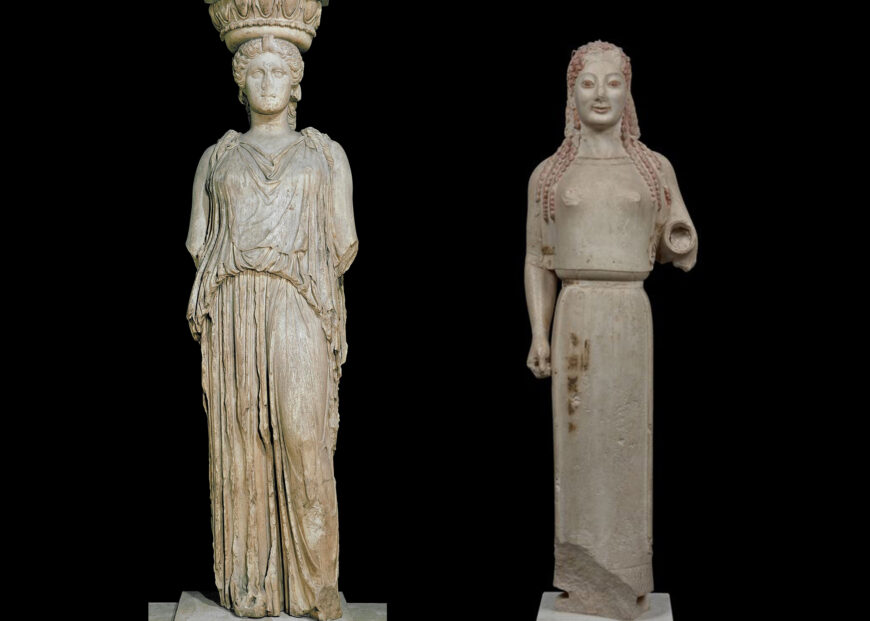
Left: Caryatid from the Erechtheion, c. 421–406 B.C.E., marble, 2.28 m high (© The Trustees of the British Museum, London); right: Peplos Kore, c. 530 B.C.E., marble, 1.2 m high (Acropolis Museum, Athens)
The Peplos Kore’s clothing is also unlike that of a typical kore. When she was first found, scholars believed that she was wearing a peplos, a garment that is made of a single rectangular piece of cloth. The cloth of the peplos is wrapped around the body and folded down at the top, with the flap of cloth usually hanging down to the waist. The peplos is then pinned at the shoulders and belted at the waist. As we can see on the caryatid from the Erechtheion, who sports a peplos, the garment leaves the woman’s arms bare. The so-called Peplos Kore does not have bare arms, and her garment is not pinned at the shoulders, suggesting that she is not wearing a peplos.
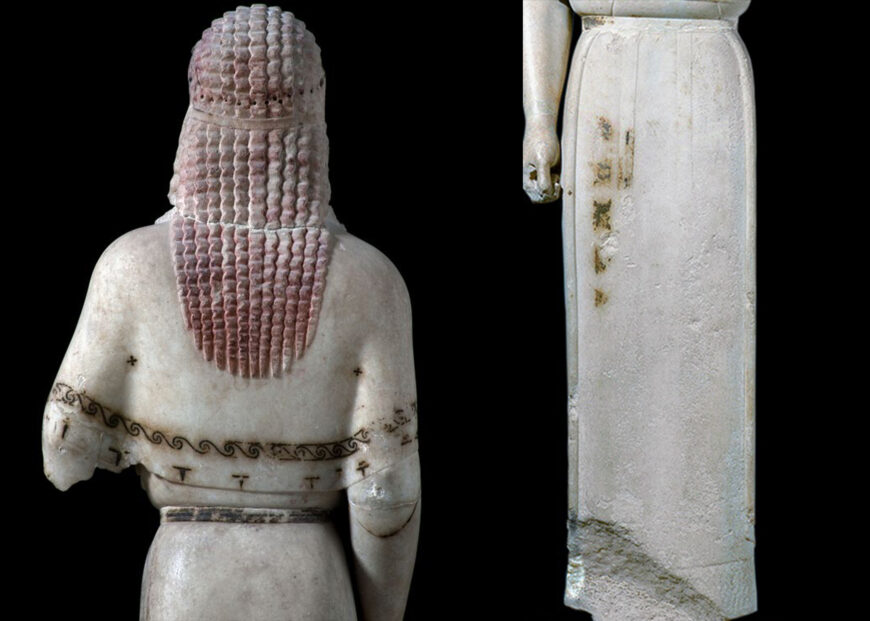
Left: back of the torso (detail), Peplos Kore, c. 530 B.C.E., marble (Acropolis Museum, Athens); right: front of skirt (detail), Peplos Kore, c. 530 B.C.E., marble (Acropolis Museum, Athens; photo: Steven Zucker, CC BY-NC-SA 2.0)
In fact, when we look at the back of the Peplos Kore, we find that she is wearing a short cloak or cape over another garment. A closer look at the front of her skirt provides another hint that she is not wearing a peplos: the marble is carved in a way that suggests two rectangular pieces of cloth are hanging vertically from just below her belt, indicating that some kind of sash held part of her garment in place. [4] Just above her feet, below the hem of her skirt, part of a pleated undergarment is visible. [5]
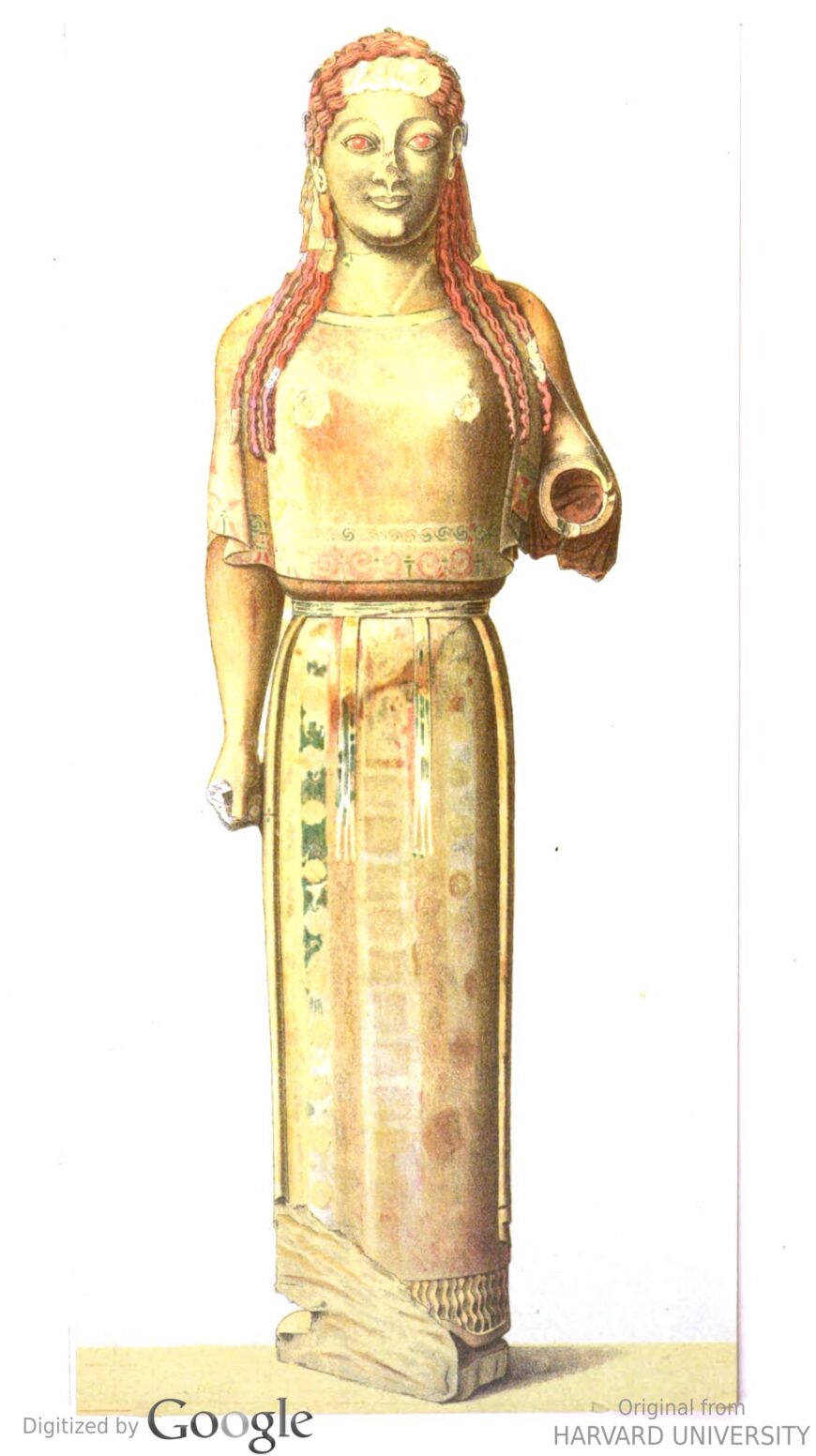
Émile Gilliéron, “Plate 9: Ancient statue from the Acropolis,” 1887, watercolor originally published as Plate 9 in Ephemeris Archaiologike
In antiquity, when the Peplos Kore was brightly painted, it would have been much easier to determine what she was wearing. When we see the statue today we might notice traces of red paint on her hair and face and dark painted patterns on her clothes. When the kore was first found in the late 1800s even more paint was visible on her, as Émile Gilliéron documented in a watercolor painting of the statue that he made shortly after she was excavated. The watercolor shows traces of blue and green paint on the kore’s cape and skirt that are no longer visible to the naked eye.

Proposed reconstruction of the Peplos Kore on display at the Ashmolean Museum in Oxford in 2015 (photo: Enrique Íñiguez Rodríguez, CC BY-SA 4.0)
Recent research has further clarified what the Peplos Kore originally looked like and what she is wearing. In the early 2000s, a team of researchers led by Vinzenz Brinkmann used new scientific methods and technologies to analyze the paint on the Peplos Kore. Their work revealed more about the remarkable painted decoration that once adorned the statue and confirmed that she is not wearing a peplos. We can see what she is actually wearing in one of the reconstructions proposed by Brinkmann. Atop her pleated undergarment, the kore wears a long sheath-like dress that is decorated with representations of animals. That dress is partially covered by the short cloak that the kore wears around her shoulders and by a mantle that she wears wrapped around her lower half, which is held in place by the sash with hanging tassels, and left open at the front to reveal the animal decoration of the dress below. [6]
The creatures that decorate the kore’s garment were an especially unexpected discovery. The dress is decorated with real and mythical animals, including a lion, a goat, and a sphinx, in a series of square panels. [7] This unusual decoration led scholars to reconsider the identity of the Peplos Kore: while most korai are understood to represent idealized but generic young women, this kore is distinguished by her elaborate, animal-covered dress, and more likely represents a specific individual. A gown embroidered with animals would be especially appropriate attire for Artemis, the goddess of wild animals and the hunt. Although the Peplos Kore was found buried on the Athenian Acropolis, which is sacred to the goddess Athena, Artemis also had a small sanctuary on the hill and may well have received dedications there. [8]
Additional details visible on the statue support the idea that the Peplos Kore is actually an image of the goddess Artemis. There is a hole in the kore’s right fist, suggesting that she once held an object made of metal. Although the kore’s left forearm is now missing, her posture reveals that she once held it out in front of her, likely grasping another object. The goddess Artemis was known to be an excellent archer, and is sometimes shown holding a bow in her left hand and an arrow in her right, as she is in one statue that is now in Boston. [9] If the kore originally held a metal bow and arrow then her identity as Artemis would be unquestionable. [10]
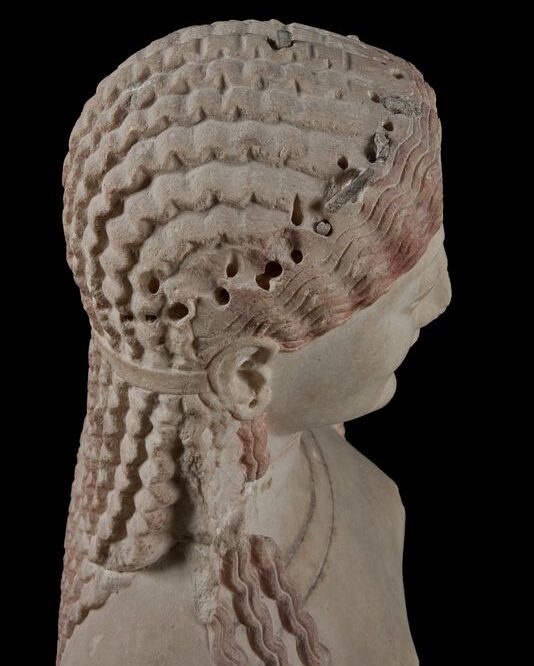
Top of head (detail), Peplos Kore, c. 530 B.C.E., marble (Acropolis Museum, Athens)
If we look at the statue from above, we see 35 holes encircling her head, as well as a central metal rod that still projects from the center of her head. These holes once secured an elaborate metal wreath or crown to the kore’s head, further distinguishing her from other, less decorated korai. [11]
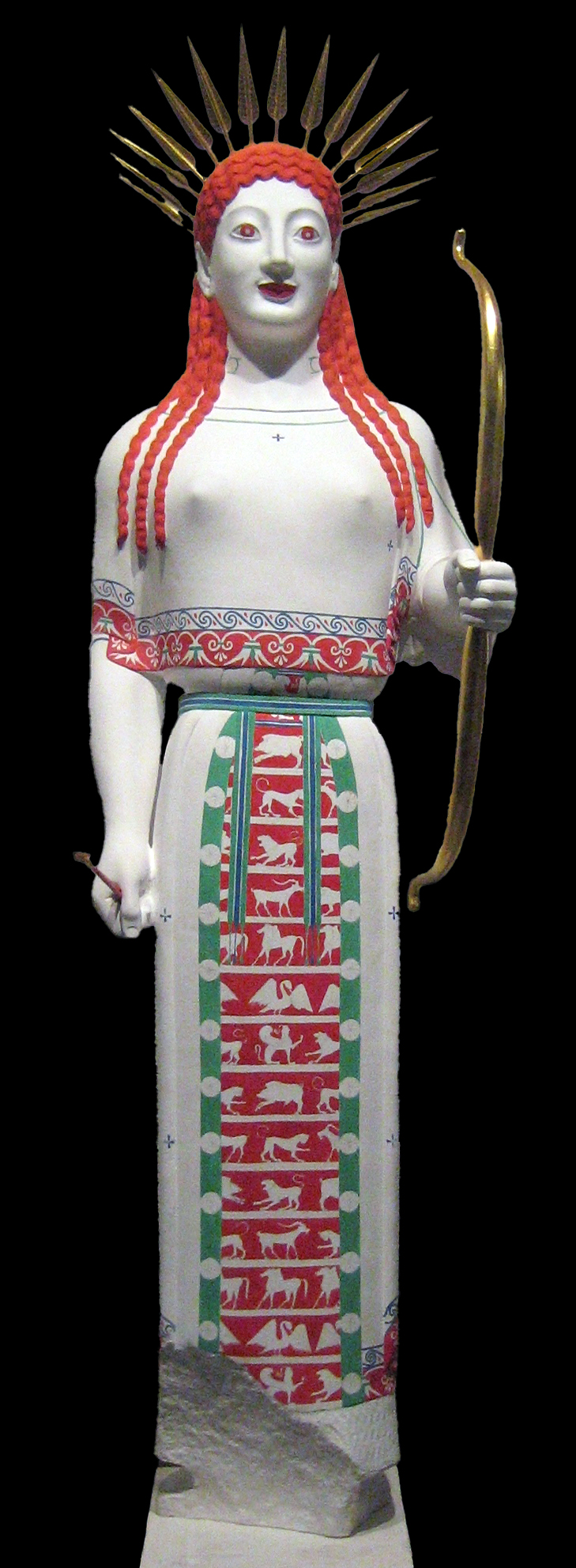
Proposed reconstruction of the Peplos Kore as Artemis (photo: Donatus Fuscus, CC BY-NC-SA 2.0)
Today, the metal attachments and elaborate paint that once enriched the Peplos Kore are absent. Without them, the kore looks quite similar to other Archaic korai. She is frontal and at first glance stiff, though further examination reveals that she is shifting slightly. She appears to wear a rectangular garment that could easily be mistaken for a peplos. It is only when we consider the decorative elements that are now missing from the Peplos Kore that we come to a better understanding of who she really was. With her brightly colored, layered garments and metal attachments, she would’ve been easily recognizable as a specific individual, quite likely the goddess Artemis. Examining the Peplos Kore reminds us that years of erosion and wear can significantly change the appearance of ancient artworks and affect our understanding of their original significance.
Notes:
[1] Andrew Stewart, Greek Sculpture: An Exploration (New Haven: Yale University Press, 1990), p. 123.
[2] Richard Neer, Art & Archaeology of the Greek World, 2nd edition (London: Thames & Hudson, 2019), p. 163.
[3] Another kore found on the Acropolis, now known as Acropolis Kore 678, has similar features and is so similar to the Peplos Kore that the two are sometimes described as sisters. Mary C. Sturgeon, “The Archaic Style in Greek Sculpture,” Handbook of Greek Sculpture, edited by Olga Palagia (Berlin: Walter de Gruyter, 2019), pp. 282–84 discusses the similarities between the two and suggests that they might have been dedicated together.
[4] Sturgeon (2019), p. 281 describes this feature as “truly unexpected.”
[5] This garment is probably a chiton, another type of ancient Greek dress.
[6] Vinzenz Brinkmann, “Girl or Goddess? The Riddle of the ‘Peplos Kore’ from the Athenian Acropolis,” Gods in Color: Painted Sculpture of Classical Antiquity (Munich: Stiftung Archäologie Glyptothek, 2007), p. 46.
[7] Brinkmann (2007), p. 46. There was also likely a human riding a horse, perhaps a hunter, in one of the panels on the kore’s garment.
[8] Sturgeon (2019), p. 282. It is also possible that this image of Artemis was dedicated to Athena: the ancient Greeks did sometimes dedicate images of gods in sanctuaries sacred to other gods.
[9] Catherine Keesling, The Votive Statues of the Athenian Acropolis (Cambridge: Cambridge University Press, 2003), p. 136.
[10] Alternatively, if the kore held a spear in her right hand, she would have been recognizable as Athena. However, Athena is not closely associated with wild animals like Artemis is. Moreover, Keesling (2003), p. 139 points out that a statue holding a large spear horizontally in her right hand would present practical issues, as it would jut into the space of the sanctuary in which it stood.
[11] Brunilde Ridgway, “Birds, ‘Meniskoi,’ and Head Attributes in Archaic Greece,” American Journal of Archaeology, volume 94 (1990), p. 609.
Additional resources
This sculpture at the Acropolis Museum
[0:00] [music]
Dr. Beth Harris: [0:04] We’re looking at a figure known as the “Peplos Kore” in the Acropolis Museum in Athens. Now, this is one of the funny things that happens in art history. Things get named based on original thoughts about something. Then, when later research is done, that name doesn’t really work anymore.
Dr. Steven Zucker: [0:20] We keep the name because everybody knows it by that name.
Dr. Harris: [0:23] Exactly.
Dr. Zucker: [0:23] This is known as the “Peplos Kore” because we originally thought she was simply wearing a peplos, which is an ancient Greek costume, a rectangle of cloth — often linen — that is pinned at the shoulders and then falls down.
Dr. Harris: [0:35] A kore is a type of figure that was found throughout ancient Greece. It’s a female figure that’s clothed. The counterpart to the male kouros, who was nude.
Dr. Zucker: [0:45] Kore simply means young woman in Greek.
Dr. Harris: [0:47] Both korai and kouroi were found in great numbers during the Archaic period, which is the period just before the Classical.
Dr. Zucker: [0:53] It’s a small sculpture and it was found on the Acropolis.
Dr. Harris: [0:57] Korai figures were generally offerings to the goddess Athena, brought, interestingly, in many cases by men.
Dr. Zucker: [1:06] Recent research suggests that this may not be a representation of a young woman at all. This might be a goddess.
Dr. Harris: [1:13] This figure is clothed in a very unusual way.
Dr. Zucker: [1:15] Among all of the sculptures of young women that were found on the Acropolis, this is the only one dressed in this way. Now, art historians are actively arguing about what it is that she’s wearing. Some still hold to the idea of a peplos.
[1:29] Some suggest that there’s a chiton underneath the peplos, some say that there’s a cape above, so there’s any number of possibilities. There’s also been research into the original coloration of the figure, which helps us understand her costume.
Dr. Harris: [1:44] What she’s wearing is so unusual and is similar to sculptures of goddesses. There’s some conjecture recently — very carefully researched conjecture — that this may in fact not be an offering, which is what’s true of most korai on the Acropolis, but that this is a goddess herself, perhaps Artemis or Athena.
Dr. Zucker: [2:04] Artemis is really important. She was the goddess of the hunt.
Dr. Harris: [2:07] She often carried a bow and arrow. What’s so frustrating about this sculpture is that we don’t have what she was carrying, which would settle once and for all a lot of questions about who she was.
Dr. Zucker: [2:18] Clearly she had her left arm straight out, bent at the elbow.
Dr. Harris: [2:22] Which was characteristic of most of the representations of these young women.
Dr. Zucker: [2:26] In this case, we think she might have been holding a bow with her left hand, and we can see her right hand [in] a fist, which is drilled in such a way that it could easily have held an arrow. She may well be Artemis, the goddess that the Romans would later call Diana.
[2:40] Let’s take a close look at the figure. We can see that there are a lot of holes crowning her head. She probably wore a metal diadem, a kind of metal crown with rays that would have come up, which certainly suggests her divinity.
Dr. Harris: [2:53] It wasn’t unusual for these female figures to wear crowns or to wear other kinds of jewelry that were represented either in paint or as metal that was applied to the sculpture.
Dr. Zucker: [3:02] We can also see that there’s a rod that rises right out of the top of her head, and some art historians have suggested that there might have been a crescent above the diadem. As you said, we can see holes for bronze earrings, which would have been there originally.
[3:14] Her face would have been more complexly painted. Only the red really survives, but we think that there was likely some black around the eyes and around the eyebrows as well as red, and perhaps some more subtle colors as well.
Dr. Harris: [3:26] The sculptor has indicated not only her breasts and her waist but also a subtle sense of her legs underneath that very heavy drapery. There’s a little bit of a sense of movement to the figure.
Dr. Zucker: [3:38] This is very much an Archaic figure.
Dr. Harris: [3:40] She does wear that Archaic smile.
Dr. Zucker: [3:42] We have to remember that that smile was not meant to be an expression of emotion, of happiness, but rather a symbol of well-being.
Dr. Harris: [3:49] That smile gives the figure a sense of being transcendent, a sense of being ideal, of not engaging in the world of emotion and difficulty but somehow rising above all that, and so that makes sense for a figure that was a goddess or a figure that represented ideal femininity.
Dr. Zucker: [4:07] I think that was probably really beautifully expressed when this sculpture was new and still brightly painted. We found traces of paint in the band at the bottom of the cloth that hangs down over her abdomen. Then, in the front of her garment that seems to part just in the middle of her torso…
Dr. Harris: [4:23] We see representation of embroidery, of decorative patterns and of animals.
Dr. Zucker: [4:28] Right, we see sphinx. We see horses. There are representations of perhaps goats. All of which is visible only under special lighting and is no longer visible to the eye.
Dr. Harris: [4:38] And perhaps suggests fecundity or fertility. It’s very difficult to know.
Dr. Zucker: [4:44] What we do know is that she is one of the most exceptional figures from the Archaic period. We’re lucky she survived for all of these years.
[4:50] [music]

